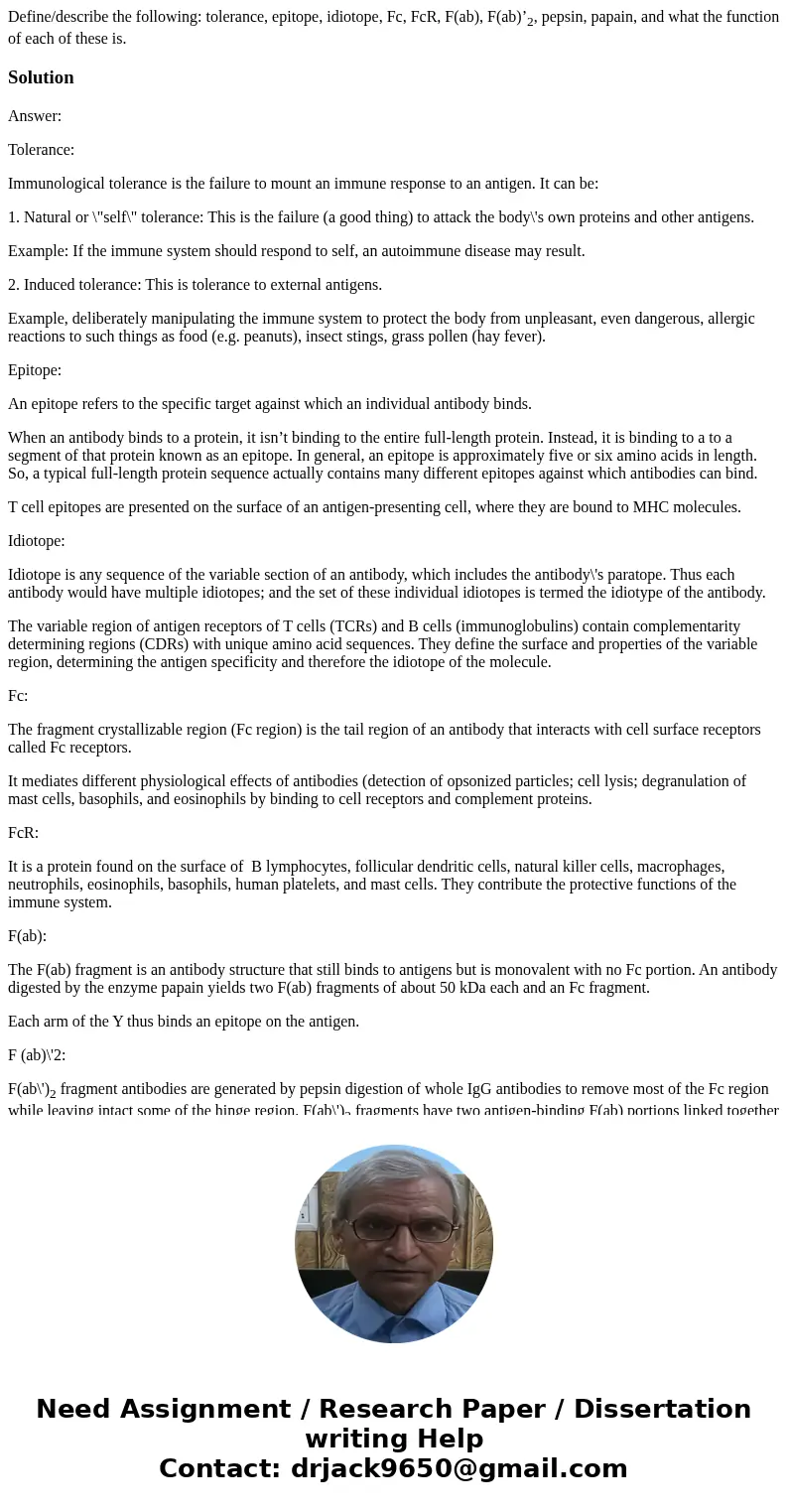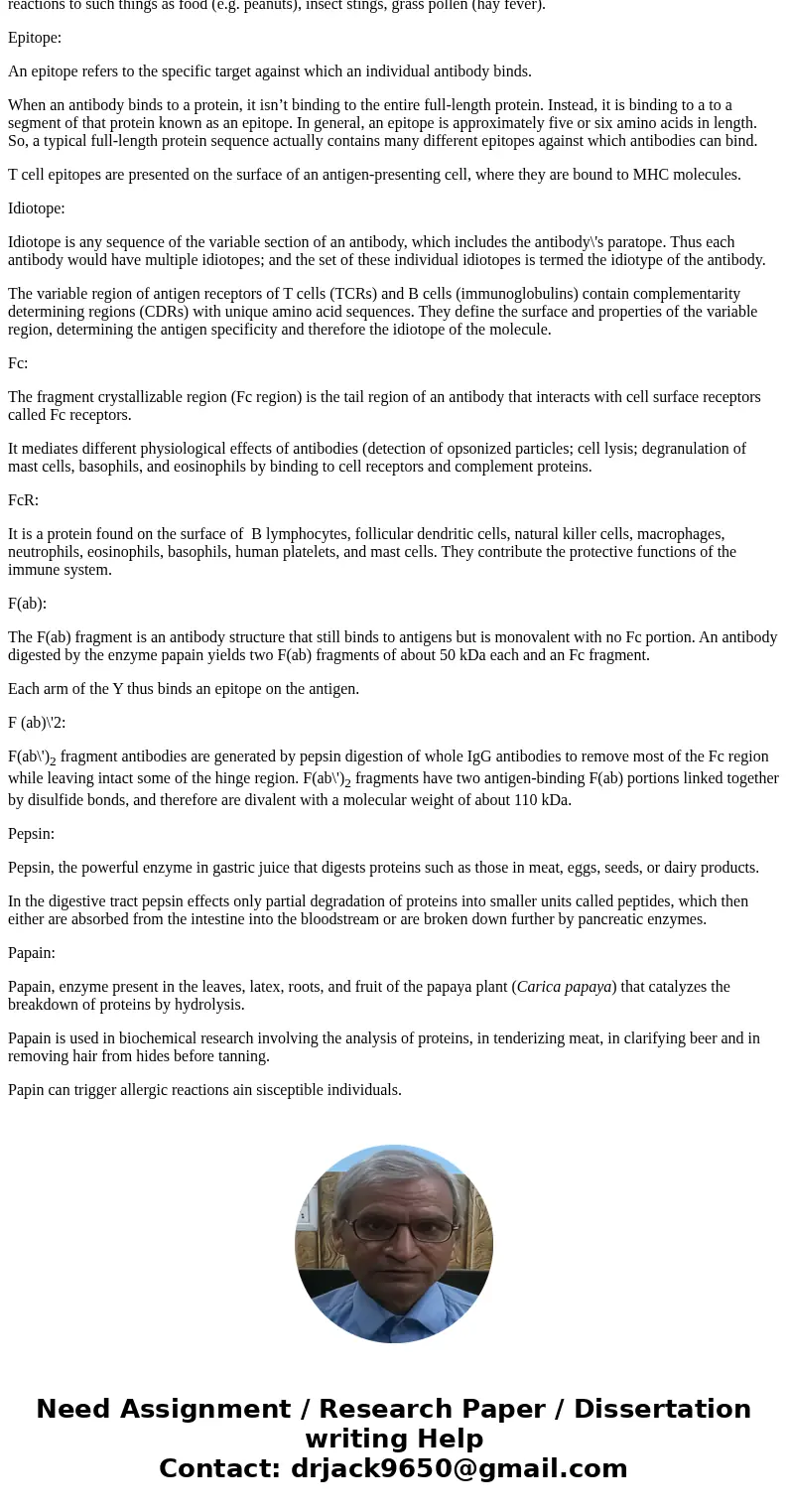Definedescribe the following tolerance epitope idiotope Fc F
Define/describe the following: tolerance, epitope, idiotope, Fc, FcR, F(ab), F(ab)’2, pepsin, papain, and what the function of each of these is.
Solution
Answer:
Tolerance:
Immunological tolerance is the failure to mount an immune response to an antigen. It can be:
1. Natural or \"self\" tolerance: This is the failure (a good thing) to attack the body\'s own proteins and other antigens.
Example: If the immune system should respond to self, an autoimmune disease may result.
2. Induced tolerance: This is tolerance to external antigens.
Example, deliberately manipulating the immune system to protect the body from unpleasant, even dangerous, allergic reactions to such things as food (e.g. peanuts), insect stings, grass pollen (hay fever).
Epitope:
An epitope refers to the specific target against which an individual antibody binds.
When an antibody binds to a protein, it isn’t binding to the entire full-length protein. Instead, it is binding to a to a segment of that protein known as an epitope. In general, an epitope is approximately five or six amino acids in length. So, a typical full-length protein sequence actually contains many different epitopes against which antibodies can bind.
T cell epitopes are presented on the surface of an antigen-presenting cell, where they are bound to MHC molecules.
Idiotope:
Idiotope is any sequence of the variable section of an antibody, which includes the antibody\'s paratope. Thus each antibody would have multiple idiotopes; and the set of these individual idiotopes is termed the idiotype of the antibody.
The variable region of antigen receptors of T cells (TCRs) and B cells (immunoglobulins) contain complementarity determining regions (CDRs) with unique amino acid sequences. They define the surface and properties of the variable region, determining the antigen specificity and therefore the idiotope of the molecule.
Fc:
The fragment crystallizable region (Fc region) is the tail region of an antibody that interacts with cell surface receptors called Fc receptors.
It mediates different physiological effects of antibodies (detection of opsonized particles; cell lysis; degranulation of mast cells, basophils, and eosinophils by binding to cell receptors and complement proteins.
FcR:
It is a protein found on the surface of B lymphocytes, follicular dendritic cells, natural killer cells, macrophages, neutrophils, eosinophils, basophils, human platelets, and mast cells. They contribute the protective functions of the immune system.
F(ab):
The F(ab) fragment is an antibody structure that still binds to antigens but is monovalent with no Fc portion. An antibody digested by the enzyme papain yields two F(ab) fragments of about 50 kDa each and an Fc fragment.
Each arm of the Y thus binds an epitope on the antigen.
F (ab)\'2:
F(ab\')2 fragment antibodies are generated by pepsin digestion of whole IgG antibodies to remove most of the Fc region while leaving intact some of the hinge region. F(ab\')2 fragments have two antigen-binding F(ab) portions linked together by disulfide bonds, and therefore are divalent with a molecular weight of about 110 kDa.
Pepsin:
Pepsin, the powerful enzyme in gastric juice that digests proteins such as those in meat, eggs, seeds, or dairy products.
In the digestive tract pepsin effects only partial degradation of proteins into smaller units called peptides, which then either are absorbed from the intestine into the bloodstream or are broken down further by pancreatic enzymes.
Papain:
Papain, enzyme present in the leaves, latex, roots, and fruit of the papaya plant (Carica papaya) that catalyzes the breakdown of proteins by hydrolysis.
Papain is used in biochemical research involving the analysis of proteins, in tenderizing meat, in clarifying beer and in removing hair from hides before tanning.
Papin can trigger allergic reactions ain sisceptible individuals.


 Homework Sourse
Homework Sourse